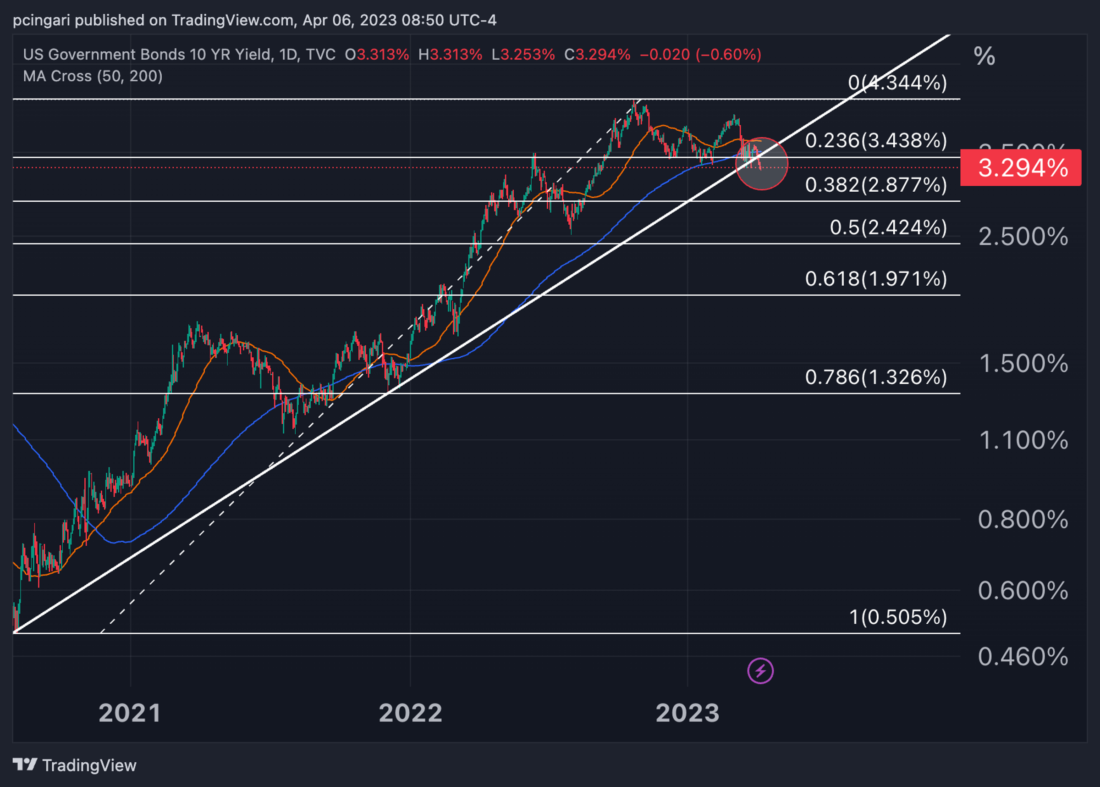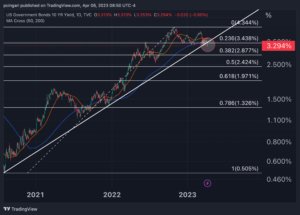ZINGER KEY POINTS
- Traders assign a greater likelihood of the Fed keeping rates on hold rather than raising them by 25 basis points in May.
- In the first week of April, U.S. 10-year yields broke below a multi-year positive trendline that began in August 2020.
U.S. Treasuries are once again serving as a safe haven for investors as they digest gloomy economic data that suggests a recession may be in sight.
Both initial and continuing jobless claims were higher than anticipated, at 228K and 1823K, respectively. Additionally, there were disappointing statistics released this week such as the ISM PMIs, ADP, and the JOLTS report, all of which indicated that tighter financial conditions are already harming the U.S. economy.
The yield on the two-year Treasury note has fallen for five consecutive sessions. This kind of run hasn’t occurred since July 2021. Yields on 10-year Treasury notes have dropped by 85 basis points to 3.25 percent from their March highs, and have reached their September 2022 lows.
Sharp declines in yields, and hence excellent price performance in Treasury bonds, have been supported by expectations of a pause in Fed rate-hiking in May, followed by a set of rate cuts this year.
According to the latest CME Group Fedwatch, traders assign a greater likelihood of the Fed keeping rates on hold (60%) rather than raising them by 25 basis points (40%) in May, and they have already factored in four rate cuts of 25 basis points by January 2024.
Will the downtrend in U.S. Treasury yields continue, or have we reached a bottom here?
Also Read: Inflation Is About To Plummet, Wall Street Firm Says: Here’s When Things Should Get Back To Normal
U.S. 10-year Yields Forecasts: Views From The Street
- Bank of America Securities forecasts 10-year Treasury rates of 3.25% by the end of 2023, in light of a second-half recession and a strong disinflationary trend.
- ING Groep N.V. sees the 10-year yield in the United States dropping to 3% by the end of the year before climbing again in the second half of next year.
- Goldman Sachs economists have an out-of-consensus forecast on U.S. Treasury yields; they expect the 10-year yield to increase to 4.2% by 2023.
Technical Analysis: US-10 Year Yields May Target 2.88% Next

In the first week of April, U.S. 10-year yields significantly broke below a multi-year positive trendline that began in August 2020. Yields have also fallen below both the 50-day and the 200-day moving averages, thus reinforcing the idea of a reversal of the major bullish trend.
According to Fibonacci retracement analysis, the next key support level might be 2.88%, which corresponds to the 38.2% retracement of the August 2020-October 2022 range.
—
Originally Posted April 6, 2023 – Recession Panic Sends Investors Flocking To Treasuries: How Low Can The 10-Year Yield Go?
Disclosure: Benzinga
© 2022 Benzinga.com. Benzinga does not provide investment advice. All rights reserved.
Disclosure: Interactive Brokers
Information posted on IBKR Campus that is provided by third-parties does NOT constitute a recommendation that you should contract for the services of that third party. Third-party participants who contribute to IBKR Campus are independent of Interactive Brokers and Interactive Brokers does not make any representations or warranties concerning the services offered, their past or future performance, or the accuracy of the information provided by the third party. Past performance is no guarantee of future results.
This material is from Benzinga and is being posted with its permission. The views expressed in this material are solely those of the author and/or Benzinga and Interactive Brokers is not endorsing or recommending any investment or trading discussed in the material. This material is not and should not be construed as an offer to buy or sell any security. It should not be construed as research or investment advice or a recommendation to buy, sell or hold any security or commodity. This material does not and is not intended to take into account the particular financial conditions, investment objectives or requirements of individual customers. Before acting on this material, you should consider whether it is suitable for your particular circumstances and, as necessary, seek professional advice.

























